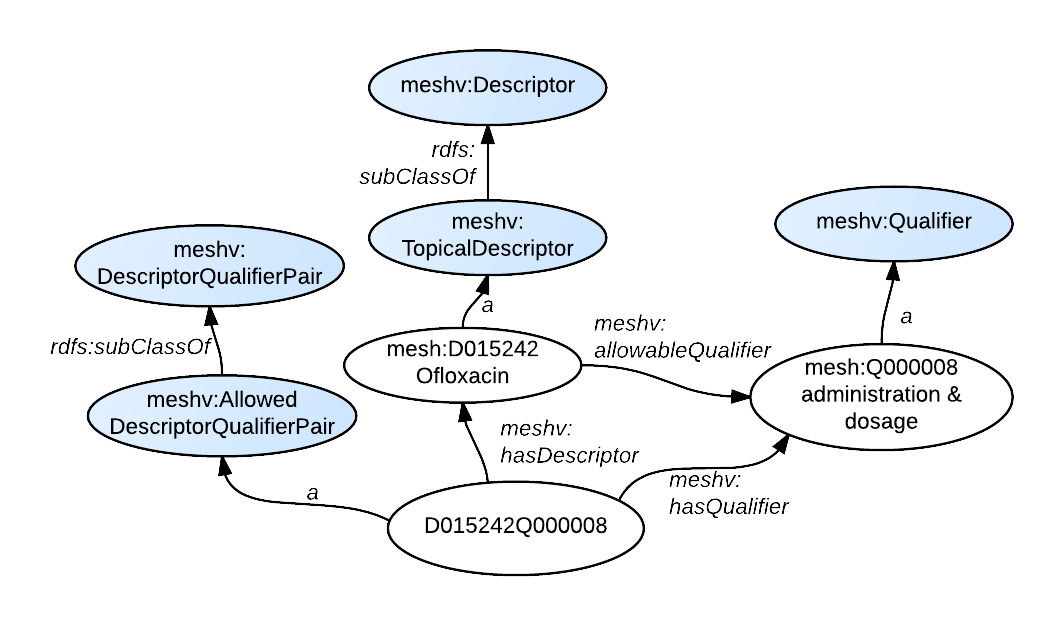Descriptor-Qualifier Pairs
When indexing or cataloging resources using MeSH, NLM pairs Descriptors (main headings) and Qualifiers (sub-headings). Qualifiers comprise a set of 83 terms used to add more specificity to descriptors. Each Descriptor has a set of Allowable Qualifiers. In RDF, Descriptors and Qualifiers may be treated as separate classes, but we have also chosen to create a class of Descriptor-Qualifier pairs, each with its own URI. For example, the pairing of a Descriptor (D015242, Ofloxacin) and one of its Allowable Qualifiers (Q000008, administration & dosage) has the following URI: http://id.nlm.nih.gov/mesh/D015242Q000008
[ jump to entry combinations ]
Class Information
In MeSH RDF, the subclasses of meshv:DescriptorQualifierPairs are:
- meshv:AllowedDescriptorQualifierPair
- meshv:DisallowedDescriptorQualifierPair
RDF Graph Diagram
The following RDF graph diagram shows how descriptor-qualifier pairs are modeled. Note that the pairing (D015242Q000008, Ofloxacin/administration & dosage) is an instance of the class, meshv:AllowedDescriptorQualifierPair. Relationships between the descriptor-qualifier pair and its respective descriptor and qualifier are explicitly defined.

meshv:DescriptorQualifierPairs - Relations and Properties
This table includes all the sub-classes of the meshv:DescriptorQualifierPairs class as either the subject or object of an RDF triple.
- Relations to other classes (as subject)
- Relations to other classes (as object)
- meshv:DescriptorQualifierPair properties
| Subject | Predicate | Object |
|---|---|---|
| meshv:AllowedDescriptorQualifierPair | meshv:hasDescriptor | meshv:Descriptor |
| meshv:AllowedDescriptorQualifierPair | meshv:hasDescriptor | meshv:GeographicalDescriptor |
| meshv:AllowedDescriptorQualifierPair | meshv:hasDescriptor | meshv:TopicalDescriptor |
| meshv:AllowedDescriptorQualifierPair | meshv:hasQualifier | meshv:Qualifier |
| meshv:DescriptorQualifierPair | meshv:hasDescriptor | meshv:Descriptor |
| meshv:DescriptorQualifierPair | meshv:hasDescriptor | meshv:GeographicalDescriptor |
| meshv:DescriptorQualifierPair | meshv:hasDescriptor | meshv:TopicalDescriptor |
| meshv:DescriptorQualifierPair | meshv:hasQualifier | meshv:Qualifier |
| meshv:DescriptorQualifierPair | meshv:useInstead | meshv:AllowedDescriptorQualifierPair |
| meshv:DescriptorQualifierPair | meshv:useInstead | meshv:Descriptor |
| meshv:DescriptorQualifierPair | meshv:useInstead | meshv:DescriptorQualifierPair |
| meshv:DescriptorQualifierPair | meshv:useInstead | meshv:TopicalDescriptor |
| meshv:DisallowedDescriptorQualifierPair | meshv:hasDescriptor | meshv:Descriptor |
| meshv:DisallowedDescriptorQualifierPair | meshv:hasDescriptor | meshv:TopicalDescriptor |
| meshv:DisallowedDescriptorQualifierPair | meshv:hasQualifier | meshv:Qualifier |
| meshv:DisallowedDescriptorQualifierPair | meshv:useInstead | meshv:AllowedDescriptorQualifierPair |
| meshv:DisallowedDescriptorQualifierPair | meshv:useInstead | meshv:Descriptor |
| meshv:DisallowedDescriptorQualifierPair | meshv:useInstead | meshv:DescriptorQualifierPair |
| meshv:DisallowedDescriptorQualifierPair | meshv:useInstead | meshv:TopicalDescriptor |
| Subject | Predicate | Object |
|---|---|---|
| meshv:DescriptorQualifierPair | meshv:useInstead | meshv:AllowedDescriptorQualifierPair |
| meshv:DescriptorQualifierPair | meshv:useInstead | meshv:DescriptorQualifierPair |
| meshv:DisallowedDescriptorQualifierPair | meshv:useInstead | meshv:AllowedDescriptorQualifierPair |
| meshv:DisallowedDescriptorQualifierPair | meshv:useInstead | meshv:DescriptorQualifierPair |
| meshv:SCR_Chemical | meshv:indexerConsiderAlso | meshv:AllowedDescriptorQualifierPair |
| meshv:SCR_Chemical | meshv:indexerConsiderAlso | meshv:DescriptorQualifierPair |
| meshv:SCR_Chemical | meshv:indexerConsiderAlso | meshv:DisallowedDescriptorQualifierPair |
| meshv:SCR_Chemical | meshv:preferredMappedTo | meshv:AllowedDescriptorQualifierPair |
| meshv:SCR_Chemical | meshv:preferredMappedTo | meshv:DescriptorQualifierPair |
| meshv:SCR_Disease | meshv:mappedTo | meshv:AllowedDescriptorQualifierPair |
| meshv:SCR_Disease | meshv:mappedTo | meshv:DescriptorQualifierPair |
| meshv:SCR_Disease | meshv:preferredMappedTo | meshv:AllowedDescriptorQualifierPair |
| meshv:SCR_Disease | meshv:preferredMappedTo | meshv:DescriptorQualifierPair |
| meshv:SCR_Protocol | meshv:preferredMappedTo | meshv:AllowedDescriptorQualifierPair |
| meshv:SCR_Protocol | meshv:preferredMappedTo | meshv:DescriptorQualifierPair |
| meshv:SupplementaryConceptRecord | meshv:indexerConsiderAlso | meshv:AllowedDescriptorQualifierPair |
| meshv:SupplementaryConceptRecord | meshv:indexerConsiderAlso | meshv:DescriptorQualifierPair |
| meshv:SupplementaryConceptRecord | meshv:indexerConsiderAlso | meshv:DisallowedDescriptorQualifierPair |
| meshv:SupplementaryConceptRecord | meshv:mappedTo | meshv:AllowedDescriptorQualifierPair |
| meshv:SupplementaryConceptRecord | meshv:mappedTo | meshv:DescriptorQualifierPair |
| meshv:SupplementaryConceptRecord | meshv:preferredMappedTo | meshv:AllowedDescriptorQualifierPair |
| meshv:SupplementaryConceptRecord | meshv:preferredMappedTo | meshv:DescriptorQualifierPair |
| Subject | Predicate |
|---|---|
| meshv:AllowedDescriptorQualifierPair | meshv:active |
| meshv:AllowedDescriptorQualifierPair | meshv:lastActiveYear |
| meshv:AllowedDescriptorQualifierPair | rdfs:label |
| meshv:DisallowedDescriptorQualifierPair | meshv:active |
| meshv:DisallowedDescriptorQualifierPair | meshv:lastActiveYear |
| meshv:DisallowedDescriptorQualifierPair | rdfs:label |
| meshv:DescriptorQualifierPair | meshv:active |
| meshv:DescriptorQualifierPair | meshv:lastActiveYear |
| meshv:DescriptorQualifierPair | rdfs:label |
SPARQL
The following SPARQL query will produce the the data shown in the RDF graph diagram above.
PREFIX rdf: <http://www.w3.org/1999/02/22-rdf-syntax-ns#>
PREFIX rdfs: <http://www.w3.org/2000/01/rdf-schema#>
PREFIX mesh: <http://id.nlm.nih.gov/mesh/>
PREFIX meshv: <http://id.nlm.nih.gov/mesh/vocab#>
construct {
?dqpair meshv:hasDescriptor mesh:D015242 .
?dqpair meshv:hasQualifier mesh:Q000008 .
mesh:D015242 meshv:allowableQualifier mesh:Q000008 .
?dqpair rdf:type ?dqclass .
?dqclass rdfs:subClassOf ?superclass .
}
from <http://id.nlm.nih.gov/mesh>
from <http://id.nlm.nih.gov/mesh/vocab>
where {
?dqpair meshv:hasDescriptor mesh:D015242 .
?dqpair meshv:hasQualifier mesh:Q000008 .
mesh:D015242 meshv:allowableQualifier mesh:Q000008 .
?dqpair rdf:type ?dqclass .
?dqclass rdfs:subClassOf ?superclass .
}
The following shows how EntryCombinations (see the MeSH documentation) are modeled.
RDF Graph Diagram
Depicted in this graph:

SPARQL
The following SPARQL query produces the RDF corresponding to the above graph:
PREFIX rdf: <http://www.w3.org/1999/02/22-rdf-syntax-ns#>
PREFIX rdfs: <http://www.w3.org/2000/01/rdf-schema#>
PREFIX mesh: <http://id.nlm.nih.gov/mesh/>
PREFIX meshv: <http://id.nlm.nih.gov/mesh/vocab#>
CONSTRUCT {
?ecin ?p ?o .
?ecin rdf:type ?eclass .
?eclass rdfs:subClassOf $superclass .
}
from <http://id.nlm.nih.gov/mesh>
from <http://id.nlm.nih.gov/mesh/vocab>
where {
?ecin meshv:hasDescriptor mesh:D000005 .
?ecin meshv:hasQualifier ?ecinq .
?ecin meshv:useInstead ?ecout .
?ecin ?p ?o .
?ecin rdf:type ?eclass .
?eclass rdfs:subClassOf $superclass .
}
